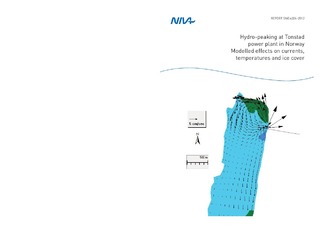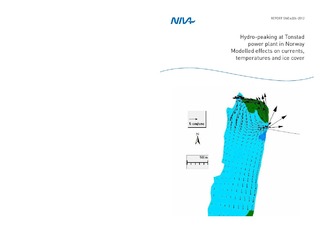| dc.contributor.author | Tjomsland, Torulv | nb_NO |
| dc.contributor.author | Bakken, Tor Haakon | nb_NO |
| dc.contributor.other | Tjomsland, T. - Project manager | nb_NO |
| dc.coverage.spatial | Vest-Agder | nb_NO |
| dc.date.accessioned | 2014-08-01T10:57:19Z | |
| dc.date.available | 2014-08-01T10:57:19Z | |
| dc.date.issued | 2012 | nb_NO |
| dc.identifier | 6326 | nb_NO |
| dc.identifier.isbn | 978-82-577-6061-8 | nb_NO |
| dc.identifier.issn | 1894-7948 | nb_NO |
| dc.identifier.uri | http://hdl.handle.net/11250/215865 | |
| dc.description.abstract | Hydro-peaking ing was done by pumping water from Sirdalsvatn to Homstølvatn by night and using it for production the following day. The effect of the hydro-peaking was simulated by mathematical modelling. Hydro-peaking led to considerably changes in water level in Homstølvatn, 3.5 m up and down each day. For Sirdalsvatn the difference was around 3/4 m. Hydro-peaking increased the current speed and current pattern especially near the openings of the tunnels in Sirdalsvatn and Homstølvatn. The vertical mixing was increased throughout the lake. In Sirdalsvatn the hydro-peaking led to reduced temperatures near surface and increased temperatures at greater depths due to increased vertical mixing, especially during the autumn and the first part of winter. The circulation period was delayed and prolonged by a week or two. In Sirdalsvatn hydro-peaking resulted in a shorter period with ice cover. In both Sirdalsvatn and Homstølvatn reduced ice cover formation may be connected to areas near the tunnel due to increased current velocities. Rapid water level changes may break up continuous ice cover along the shores. | nb_NO |
| dc.description.sponsorship | The Research Council of Noway / CEDREN | nb_NO |
| dc.publisher | Norsk institutt for vannforskning | nb_NO |
| dc.relation.ispartofseries | NIVA-rapport;6326 | nb_NO |
| dc.rights | Navngivelse-IkkeKommersiell-DelPåSammeVilkår 3.0 Norge | nb_NO |
| dc.rights.uri | http://creativecommons.org/licenses/by-nc-sa/3.0/no/ | nb_NO |
| dc.subject | environmental informatic | nb_NO |
| dc.title | Hydro-peaking at Tonstad power plant in Norway Modelled effects on currents, temperatures and ice cover | nb_NO |
| dc.type | Research report | nb_NO |
| dc.rights.holder | Norsk institutt for vannforskning/Norwegian institute for water research | nb_NO |
| dc.subject.nsi | VDP::Matematikk og naturvitenskap: 400 | nb_NO |
| dc.source.pagenumber | 55 | nb_NO |
| dc.subject.keyword | effektkjøring | nb_NO |
| dc.subject.keyword | vannstand | nb_NO |
| dc.subject.keyword | strøm | nb_NO |
| dc.subject.keyword | temperature | nb_NO |
| dc.subject.keyword | is | nb_NO |
| dc.subject.keyword | matematisk modellering | nb_NO |
| dc.subject.keyword | tonstad kraftverk | nb_NO |
| dc.subject.keyword | norge | nb_NO |
| dc.subject.keyword | hydro-peaking | nb_NO |
| dc.subject.keyword | water level | nb_NO |
| dc.subject.keyword | current | nb_NO |
| dc.subject.keyword | temperature | nb_NO |
| dc.subject.keyword | ice cover | nb_NO |
| dc.subject.keyword | mathematical modelling | nb_NO |
| dc.subject.keyword | tonstad power plant | nb_NO |
| dc.subject.keyword | norway | nb_NO |
| dc.relation.project | 10198 | nb_NO |


